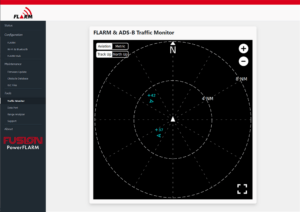PowerFLARM Fusion
Clear Configuration
Proper configuration is important for every FLARM device, as the collision warning algorithms adapt to the aircraft in which the device is installed. The new Status and Configuration pages make this easier than ever before. Configuration changes are instantly applied, and the current configuration can easily be verified and printed for documentation purposes.
The Status page shows the condition of the system, indicating firmware, obstacle, and error conditions. Four physical LED lights, known from (and missed since) Classic FLARM, have found their way back in PowerFLARM Fusion, and are also replicated on the Status page.

Traffic Monitor
A radar-like traffic monitor shows all aircraft seen by FLARM (including ADS‑B traffic) and can be used for installation and configuration verification as well as for maintenance purposes.

Built-in Range Analyzer
The new CARP range analyzer, which continuously evaluates the measured range during flight, is now integrated into FLARM Hub using the same visualization as the online version. This makes it possible to verify the radio range on the airfield after any flight.

Diagnostics & Support
A plethora of FLARM displays and other accessories are available from a wide range of manufacturers. In addition, many tablet and smartphone apps can show traffic information from PowerFLARM Fusion directly, using its integrated Bluetooth and Wi-Fi dual radio. There is no need for an additional bridge device. Depending on the connected app, Fusion can stream either the complete data set via the FLARM data port protocol or limited traffic information using the GDL 90 protocol. This includes apps like Air Navigation Pro, Airmate, EasyVFR, ForeFlight, Helios Horizon, Sky-Map, SkyDemon, and XCSoar.
Connectivity
A plethora of FLARM displays and other accessories are available from a wide range of manufacturers. In addition, many tablet and smartphone apps can show traffic information from PowerFLARM Fusion directly, using its integrated Bluetooth and Wi-Fi dual radio. There is no need for an additional bridge device. Depending on the connected app, Fusion can stream either the complete data set via the FLARM data port protocol or limited traffic information using the GDL 90 protocol. This includes apps like Air Navigation Pro, Airmate, EasyVFR, ForeFlight, Helios Horizon, Sky-Map, SkyDemon, and XCSoar.
Painless Upgrade
The familiar antenna and data connections on PowerFLARM Fusion make it effortless to upgrade from a PowerFLARM Core. The form factor and mounting holes are identical. An adapter kit for the updated antenna connectors is available, allowing the use of existing antennas and cables.

All Options Included
PowerFLARM Fusion comes included with everything that is taken for granted in a modern PowerFLARM device: extended range, antenna diversity, improved interference and ESD protection, ADS-B & Mode-S receiver, wireless connectivity, and intuitive obstacle warnings (databases sold separately). Options that previously required a license are now included: IGC, ENL, Antenna Diversity (RFB), and Audio Out.
Same, but Better
PowerFLARM revolutionized aviation by establishing the system that had been so successful in gliding as the solution for avoiding mid-air collisions in all of General Aviation. PowerFLARM Fusion is the same PowerFLARM that you love, but with novel features making managing it ultraconvenient. Being safe has never been as accessible as now.
 PowerFlarm fusion product sheet
PowerFlarm fusion product sheet
Adapter:
To use your existing flarm antenna the adapter is needed.
The ports on the Powerflarm are reversed to previous versions.
This means current flarm antennas you already use in the glider will not connect without the adapter.
The ports for flarm on this device are Female RPSMA
Current flarm antennas use Male SMA
See pic below for guidance:

